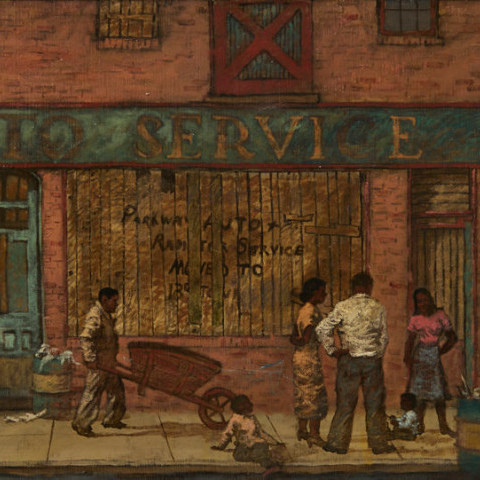Hughie Lee-Smith knew from an early age that art would be his "mission." A classically trained artist, his diverse influences range from the metaphysical imagery of the Italian painter Giorgio de Chirico to the romantic realism of Edward Hopper. Lee-Smith concedes, "In my case, aloneness, I think, has stemmed from the fact that I'm black. Unconsciously it has a lot to do with a sense of alienation." Although his feelings about racial inequities or disharmonies have been inspirational, he seeks to create images that articulate his emotions about social and cultural disparity as it relates to all of humanity. His interest in people and their relationship to the world has been unwavering. While Lee-Smith's dramas have included both black and white protagonists, they are almost always isolated in the landscape and from each other.
The Stranger [SAAM, 1994.15] is a compilation of outdoor sketches and photographic studies of midwestern landscapes later filtered through the artist's imagination. The tidily clustered houses and outbuildings are picturesque and welcoming but, apparently, inaccessible to the young man who has paused in the field, perhaps in the act of departure or skirting the town. A road or dry river bed cuts through the raw earth, aformal device that reinforces the figure's separation from the dwellings above. In an effort to symbolize "everyman," his race is also ambiguous.
Although the artist believes the painting may have been originally exhibited under the title Town Beyond Slope, he retitled it The Stranger in 1994, after seeing the work for the first time in almost thirty years. Lee-Smith was struck by the figure's positioning in relationship to the town, which he now reads as affluent. "My feelings and emotions [about the painting] are different today, but it is from my brush and my soul," he says. Lee-Smith continues to explore the universality of human loneliness through his silent, mysterious images, always tempered with a cautious optimism about the prospect of restoration and equality.
Lynda Roscoe Hartigan African-American Art: 19th and 20th-Century Selections (brochure. Washington, D.C.: National Museum of American Art)




